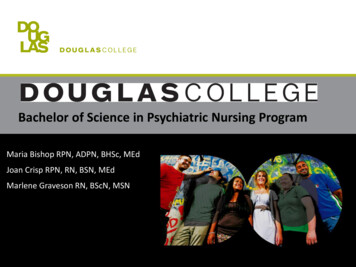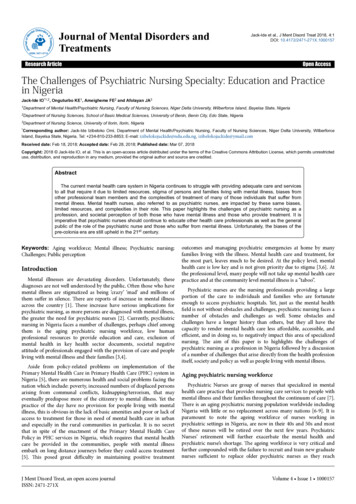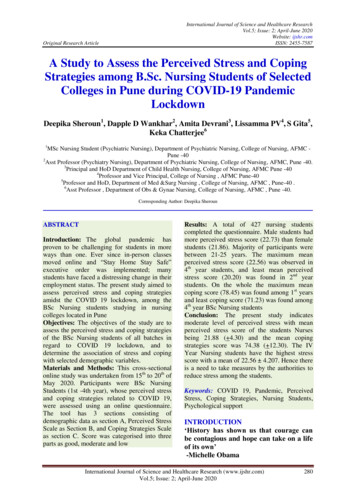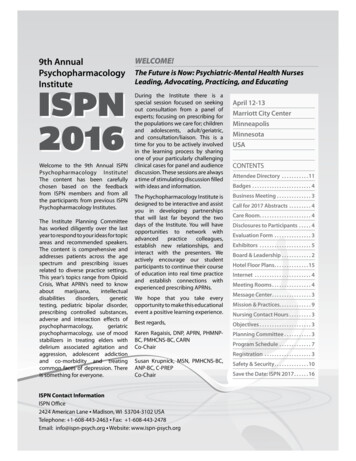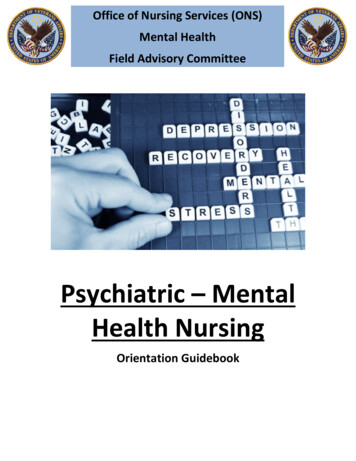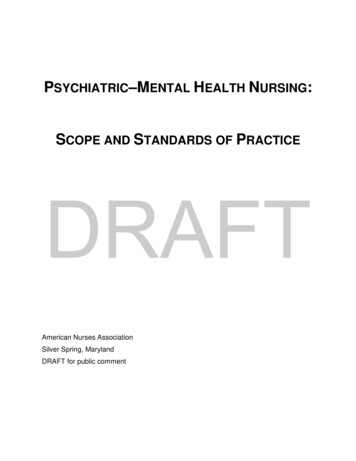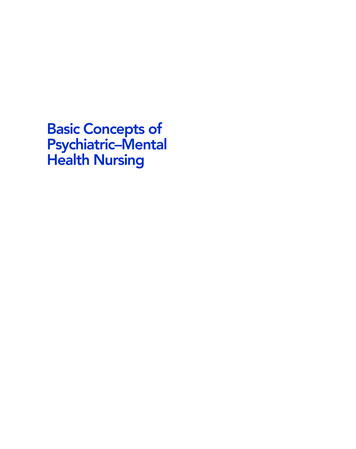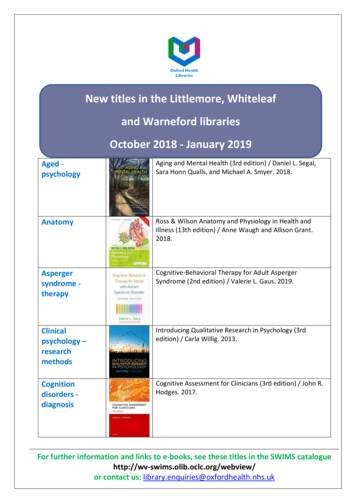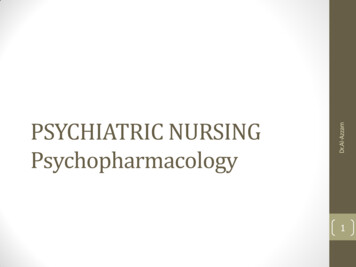
Transcription
Dr.Al-AzzamPSYCHIATRIC NURSINGPsychopharmacology1
Specific outlines a. Antianxiety agentsb. Antidepressantsc. Mood stabilizersAntipsychoticsAntiparkinsonian agentsDr.Al-Azzam Discuss historical perspectives related to psychopharmacology. Describe indications, actions, contraindications, precautions,side effects, and nursing implications for the followingclassifications of drugs: Sedative-hypnotics Agents for attention-deficit/hyperactivity disorder Apply the steps of the nursing process to the administration ofpsychotropic medications.2
- Prior to the 1950s psychopharmacology was notavailable – focus was on behaviouralinterventions and sedatives- The advent of psychopharmacologic agentsdramatically lowered the numbers of inpatients– thousands were released from hospital care- Nowadays, psychopharmacology is a primarytreatment mode of psychiatric illnesses- - Nurses are required to understand and updatetheir knowlege on current advances inpsychopharmacologic nd information3
Discoveries of new medications to treat mental illnesses occuralmost monthly This new frontier of psychiatric thought, research andtreatment greatly affects nursing practice Medications are combined to find the most suitable ones onan individual basis, which may require trying a number ofalternatives before finding the right one/sDr.Al-AzzamPsychopharmacologyBackground information (cont d)4
Although we still use classifications such asantipsychotic and antidepressant, thenomenclature neuroleptic and psychotropic isused to indicate that the medication can be usedacross diagnostic groups Many medications now have multiple indications For example, Antipsychotics are no more usedsolely for their original purpose Psychotropic medications are medications thataffect cognitive funcion, emotion and cs and neuroleptics5
Psychopharmacology 1.2.3.4.Recently, there has been a significant change inthe use of classes of medications forpsychiatric symptomatologyDespite this, you will still encounter the mainclassification of psychotropics into four olyticMood-stabilizingDr.Al-AzzamPsychotropics and neuroleptics (cont d)6
Reducing as many of the psychotic symptoms aspossible, enables patient to participate moreeffectively in other forms of treatment It may take 2-4 weeks to see improvement Some people respond better to one drug than toanother – idiosyncracy Choosing the medication also depends on itsside-effects – again, idiosyncratic Half of the medicated people get side-effectsbecause of which they discontinue themedication (loss of compliance or ic medications7
There are conventional and new-generation oratypical antipsychotics Some patients respond better to conventionalmedication (e.g. Chlorpromazine), althoughatypical agents (e.g. Zyprexa, Risperdal) havebeen found to be more effective and safe inlong-term treatment Conventional (as well as some atypical) agentscan have very serious otic medications (cont d)8
PsychopharmacologyAntipsychotic medicationsSide-effectsacetylcholine, the chemical transmitter by which the vagus nerve stimulates the stomach andintestines.)- Photosensitivity- Extrapyramidal side-effects (EPS)Dr.Al-Azzam The most common side-effects of conventional antipsychoticmedications include:- Anticholinergic effects (an anticholinergic is a drug that inhibits the action of9
PsychopharmacologyAntipsychotic medicationside-effects (cont d) Extrapyramidal side-effects (EPS)- Akathisia: (Gk. Not being able to sit). Feeling restless or jittery, needing to fidget, pace- Dystonia: sudden muscle spasm characterized by torticollis (twisting of neck),opisthotonos (spasm of the neck and back forcing the head backwards), oculogyric crisis (afixed gaze that cannot return to lateral)- Parkinsonism: tremor, stiffness, rigidity, stooped posture, shuffling gait, akinesiaDr.Al-Azzamaround, be about(feeling slowed down), pill-rolling movement of fingers, oscillations of distal parts ofextremities- Neuroleptic malignant syndrome: muscle rigidity, hyperpyrexia,hypertension, confusion, delirium- Tardive dyskinesia: involuntary movements of face and body (lipsmacking, tongue protrusion, rocking, foot tapping), impaired gait and posture10
TARDIVE DYSKINESIA (cont d)- Many of the cases are mild but the disorder can be sociallydisfiguring. The symptoms of frowning, blinking, grimacing,puckering, blowing, smacking, licking, chewing, tongueprotrusion and spastic facial distortions are very troubling.Abnormal movements of the arms and legs also occur,including rapid, purposeless irregular movements; tremorsand foot tapping. Body symptoms include dramaticmovements of the neck and shoulders, rocking, twisting pelvicgyrations and thrusts.- Because tardive dyskinesia is often irreversible, the goal isprevention.- If symptoms begin to appear, the medication is reduced or theperson is switched to a newer chotic medicationside-effects (cont d)11
Interference with sexual functioning is fairly common.Almost half report weight gain.Identifying and managing side effects is important.Some people stop taking their medication and relapsewhereas others relapse first, and as a result, stop takingtheir medication. Monitoring white blood cells is essential with somemedications as agranulocytosis is common with somedrugs and can be fatal, since the patient can easilysuccumb to an overwhelming ic medicationside-effects (cont d)12
The primary symptom of overdose is CNS depression, whichmay extend to the point of coma. Other symptoms include agitation, restlessness, seizures,fever, EPS, arrhythmias, and hypotension. Caring for a client with overdose includes monitoring vitalsigns, especially of cardiac function; maintaining a patentairway and gastric lavage. Antiparkinsonian medications may be given for EPS. Valium (Diazepam) may be given for c medicationToxicity and overdose13
Administration of antipsychotic medication isoral, in liquid or pill form, or by injection Long-acting injectable medications such asProlixin (fluphenazine) decanoate and Haldol(haloperidol) decanoate are often used to treatclients with schizophrenia. These medications are administered IM onceevery 3-4 weeks. A helpful regimen for clientswho have difficulty remembering to takemedications daily or who would otherwise ychotic medicationAdministration14
The neurotransmitters involved in depression aredopamine (DA), serotonin (5-HT),norepinephrine (NE) and acetylcholine (ACH). It is believed that during depressive episode,there is a functional deficiency of theseneurotransmitters or hyposensitive receptors. Antidepressant medications increase the amountof available neurotransmitters by inhibitingneurotransmitter reuptake, by inhibitingmonoamina oxidase (MAO) or by blockingcertain receptors. (Thase and Howland, 1995)Dr.Al-AzzamPsychopharmacologyAntidepressant medicationPhysiological effects15
Antidepressant medications can be classified as: Older generation agents: multicyclics andmonoamine oxidase inhibitors (MAOIs) New generation agents: selective serotoninreuptake inhibitors (SSRIs) and serotoninnorepinephrine reuptake inhibitors (SNRIs). The new generation medications havedramatically changed the treatment ofdepression, with more effective action and fewerside t medicationTherapeutic effects16
Depressions are heterogenous in terms of whichneurotransmitters are depleted, which is why differentpeople respond differently to various antidepressants. Often, a period of trial and error is necessary todetermine which medication is the most effective. Maintenancecontinues until clients are free of symptomsfrom 4 months to 1 year. Then the drugs are slowydiscontinued. The therapeutic purpose of antidepressants is todecrease as many of the depressive symptoms aspossible, THEREBY ENABLING THE CLIENT TOPARTICIPATE MORE EFFECTIVELY IN OTHER FORMS ssant medicationTherapeutic effects (cont d)17
Antidepressants do not cause dependence, tolerance,addiction or withdrawal. It takes an average of 10-14 days for the beginning effect andfull effect may not be apparent for 4-6 weeks. When a client does not respond at all after a trial period of 46 weeks, a different antidepressant is tried or a combinationof other medications. A significant number of clients improve when 600mg oflithium is added to antidepressant treatment. Other clients improve when triiodothyronine (T3) isadministered daily. For delusional or severely agitated clients antipsychoticmedication may be ant medicationTherapeutic effects (cont d)18
Both multicyclics and MAOIs may have anticholinergic effects such as drymouth, blurred vision, urinary retention and constipation. CNS effects include drowsiness, lethargy, insomnia and restlessness. Orthostatic hypotension and tachycardia may occur in the early phases oftreatment The best know side effects are sexual dysfunction and weight gain. Some medications cause great sexual impairment and excessive weightgain, e.g. Elavil (amitriptyline), Adapin (doxepin) and Anafranil(clomipramine). Least sexual side effects and weight gain is experienced with Norpramin(desipramine) and Pamelor (nortriptyline). Weight gain with latter is 0-10 pounds and with formerly mentionedmedications 5-40 pounds.Dr.Al-AzzamPsychopharmacologyAntidepressant medicationSide effects19
The SSRIs and SNRIs have fewer anticholinergic effects, fewercardiac effects, fewer sexual problems, less sedation and lessweight gain. MAOIs decrease the amount of monoamine oxidase in theliver, which breaks down the essential amino acids tyramineand tryptophan. If a person eats food that is rich in thesesubstances he or she risks hypertensive crisis. The first sign of hypertensive crisis is a sudden and severeheadache, followed by neck stiffness, nausea, vomiting andtachycardia. Death can result from circulatory collapse orintracranial nt medicationSide effects (cont d)20
FOOD TO AVOID WITH MAOIs Absolutely restricted:- Aged cheeses; aged and cured meats; improperly stored orspoiled meat, fish or poultry; banana peel; broad bean pods;sauerkraut; soy sauce and other dosy condiments; draft beer. Consume in moderation:- Red or white wine (no more than two 4-oz glasses per day);bottled or canned beer, including non-alcoholic (no more thantwo 12-oz servings per day).Dr.Al-AzzamPsychopharmacologyAntidepressant medicationSide effects (cont d)(Gardner, 1996)21
The SSRIs and SNRIs increase the availability of 5-HT,which relieves depression but can also cause thehyperserotonergic state known as the serotoninsyndrome (SS). This syndrome is more likely to occur when theseagents are used in combination with MAOIs. SS develops very quickly and must be attended toimmediately. Characteristic symptoms are: high fever,confusion, hypomania, tachycardia, diaphoresis,disco-ordination and nt medicationSide effects (cont d)22
Symptoms of toxicity are varied and must be noticed immediately. If MAOIs and other antidepressants are administered together,serious reactions may occur. CAUTION! Seven to 14 days should elapse between the use ofMAOIs and other epressant medicationToxicity and overdose23
PsychopharmacologyAntidepressant medicationAdministrationDr.Al-Azzam Oral Usually takes 2-4 weeks to reach therapeutic levels Changes may be observed by others before client recognizes them24
Benzodiazepine antianxiety medications act on thelimbic system and the reticular activating system(RAS). They produce a calming effect by potentiating theeffects of gamma aminobutyric acid (GABA), on ofthe inhibitory neurotransmitters. CNS depression can range from mild sedation tocoma. Other physiological effects include skeletal musclerelaxation and anticonvulsant y medicationPhysiological effects25
Different medications are effective in various anxietydisorders. Individual benzodiazepines differ in potency, speed incrossing the blood-brain barrier, and degree ofreceptor binding. High-potency and short-acting benzodiazepinesinclude Xanax (alprazolam), Ativan (lorazepam),Paxipam (halazepam) and Serax (oxazepam). Low-potency and long-acting benzodiazepinesinclude Tranxene (clorazepate), Valium (diazepam)and Librium tianxiety medicationTherapeutic effects26
Side effects of benzodiazepines are primarily relatedto the general sedative effects including drowsiness,fatigue, dizziness and psychomotor impairment. These medications potentiate the effects of alcoholand can lead to severe CNS depression. Intravenous administration can lead tocardiovascular collapse and respiratory y medicationSide effects27
There is a potential for abuse in vulnerable client populations. BuSpar (buspirone) has no potential for dependence and does notpotentiate the effects of alcohol on the CNS. It is the drug of choice for clients who are prone to substance abuseor for those who require long-term treatment with gyAntianxiety medicationSide effects (cont d)28
Symptoms of toxicity include euphoria, slurred speech,disorientation, unsteady gait and impaired judgment. Symptoms of overdose include respiratory depression, cold andclammy skin, hypotension, weak and rapid pulse, dilated pupils andcoma. These must be reported ty medicationToxicity and overdose29
All antianxiety medications may be taken orally. Antacids interfere with the absorption of thesemedications and should not be taken until severalhours later. Some medications may be administered IM or IV. Benzodiazepines should not be discontinuedabruptly because of the risk of withdrawalsymptoms. They shoudl be gradually reduced iety medicationAdministration30
Mood stabilizers include a small group of diverse medications Lithium is the best known and most often prescribed moodstabilizer. In recent years, several anticonvulsant medications have beenadded to this category: Tegretol (carbamazepine), Depakeneand Depakote (valproate) and Klonopin (clonazepam). Calcium channel blockers (Calan and Isoptin) are increasinglybeing used with success in manic disorders either alone or incombination with other mood stabilizers. They have beenfound to be effective in the treatment of bipolar disorder andseem to work best in people who also respond to ing medicationPhysiological effects31
The specific action of these medications is unclear. In the body, lithium substitutes for sodium, calcium,potassium and magnesium. It also interacts withneurotransmitters. Like antidepressants, lithium normalizes REM sleepabnormalities which are present in mood disorders. Mood stabilizers which increase GABA activity seemto have an antimanic, antipanic and d-stabilizing medicationPhysiological effects (cont d)32
Manic episodes may be triggered by persistent low-levelstimulation of the brain referred to as ”kindling”. The anticonvulsants may be effective in that they block thispersistent stimulation. Clients with acute manic episode have been found to haveincreased levels of intracellular calcium, which decrease whenlithium is bilizing medicationPhysiological effects (cont d)33
For clients with problems such as bipolar disorder,major depression, schizoaffective disorder,treatment-resistant schizophrenia, alcoholwithdrawal, and other mood-regulation problems,mood-stabilizing medication has been found to behelpful. The antimanic effectiveness of lithium is 60-70%;some people seem to be resistant to it and otherscannot tolerate the side effects. Because it takes 1-3 weeks to control symptoms,antipsychotic medication or benzodiazepines aregiven initially for more immediate ng medicationTherapeutic effects34
The early side effects of lithium often disappear after 4 weeks. These side effects include lack of spontaneity, memoryproblems, difficulty concentrating, nausea, vomiting,diarrhoea and hand tremors Weight gain and a worsening of acne often persist throughouttreatment Women taking Tegretol (carbamazepine) may have menstrualcycle irregularities and experience false positive pregnancytests. Weight gain is the side effect which causes most complaintsand is the major cause of discontinuing mood ilizing medicationSide effects35
There is a fine line between therapeutic levels and toxic levelsof lithium. Mild lithium toxicity: serum level about 1,5 mEq/L (apathy,decreased concentration, slight twitching, coarse tremors) Moderate lithium toxicity: serum level about 1.5-2.5 mEq/L(severe diarrhoea, vomiting, tinnitus, blurred vision, tremors) Severe lithium toxicity: serum level above 2.5 mEq/L(nystagmus, dysarthria – speech difficulty due to impairmentof the tongue, visual or tactile hallucinations, oliguria oranuria, confusion, seizures, coma or g medicationToxicity and overdose36
The administration of lithium is oral, in capsule orliquid form. Both carbamazepine and valproate are available intablet and liquid forms. Initially low doses areincreased gradually. The ultimate dosages are determined by reduction ofsymptoms, blood levels and side effects. Patients must continuously be monitored forhypotension and ilizing medicationAdministration37
ADHD Through The Life CycleDrugs Used For TreatmentDr.Al-Azzama) Ritalin (methylphenidate)(Various forms, Concerta)b) Dextro-amphetamines (Various forms)c) Tricyclics and/or antihipertensivesd) Wellbutrin, Clonidine, neuroleptics etce) Monoamine oxidase inhibitors (effective but verydangerous, particularly in children)f) Focalin and Ritalin Lag) Atomoxetine (Strattera)38 Drugs most used are various forms of:
ADHD Through The Life CycleDrugs Used For TreatmentDr.Al-AzzamComes in several forms:a) Straight Ritalin (5, 10, and 15 mg) (3 ½ H)b) SR Ritalin (Ciba 20 mg) (not recommended)c) Metadate CD, ER, (Celltech 20 mg) (5-6 H)d) Concerta(ER) (18, 27, 36 and 54 mg) ( 11- 12 H)e) FocalinTM (2.5, 5, 10 mg) (Out recently)f) Ritalin LA (20, 30, 40 mg) ( 7 hours ?)(Sprinkle)39 Ritalin is classified as a psychostimulant drug
ADHD Through The Life CycleDrugs Used For Treatment 2) Slow releases:a) Dexedrine SR (5, 10 and 15 mg) (7-10 H)b) Adderall XR (10, 20 and 30 mg capsules) (7-10 H)Dr.Al-Azzam 1) Most used straight release are:a) Dexedrine (5mg), (4 ½ H)b) Dextrostat (5 and 10 mg) (4 ½ H)c) Adderall (5, 10, 20 mg) (4 ½ H)40Dextro-amphetamines:
ADHD Through The Life CycleDrugs Used For Treatment 3) Can monitor plasma drug levels (for safety andcompliance) 4) No risk of abuse, small doses of 10-25 mg 5) Some death reports in children with TCA’s(next)Dr.Al-Azzam 2) No rebound or insomnia problems41Tricyclic antidepressants: 1) Longer duration of action (once daily dosing)
Tricyclic Antidepressants (cont)b) Better to use Desipramine (less sideeffects, may respond by third day)c) Nortriptiline (not generally used) Always monitor cardiovascular side effectsDr.Al-Azzam42 Those more frequently used in the past were:a) Norpramin (imipramine desipramine)-Dirty, many side effects
ADHD Through The Life CycleDrugs Used For Treatment The Use of Catapres (Clonidine), and Tenex:as 2) Reduce the activation or arousal of ADHD,syndrome and aggressionTourette’s 3) Used in highly irritable, impulsive and(next)aggressive childrenDr.Al-Azzam43 1) Clonidine is an imidazoline derivative usedantihypertensive agent
ADHD Through The Life CycleDrugs Used For Treatment 6) Not useful to control distractability itself 7) Helps sleep if taken in late afternoon(next)Dr.Al-Azzam 5) Useful in motor tics, overactive ADHD, growthimpairment44 4) On occasion Clonidine is given with Ritalin orDexedrine with optimal results
ADHD Through The Life CycleDrugs Used For Treatment 10) Excretion half life 8-12 H but very variable 11) May take 2 - 4 weeks to see response(beyond sedation)(next)Dr.Al-Azzam 9) Major side effect is sedation starting 30-60’ afterdoses is taken45 8) Can be taken up to 3x q.d ( 6 hours interval) atdoses of up to 0.1 mg (total of 0.3-0.3 ½ mg)
ADHD Through The Life CycleDrugs Used For Treatment 14) Guanfacine (Tenex) has the sameindications of ClonidineDr.Al-Azzam 13) Guanfacine (Tenex) can be given in dosesof 1-3 mg q.d (6 hours interval betweendoses)46 12) Patches can be used delivering 0.1-0.3 mgq.d for a week according to size of patch
New Drug on the MarketDr.Al-Azzam47 Atomoxetine (Strattera) is a re-uptake inhibitor ofnorepinephrine . It is not a psychostimulant. Best doses seems to be 1.2 mg/kg/day Now approved. Limited experience with it. Does notexacerbate tics. Covers patient 24 hours. No safetyconcerns as with tricyclics. Not controlled by FDA Side effects: Decreased appetite, nausea, loss of weight,somnolence, etc. Loss of libido (7%). Non-addictive.
Observe closely! For example:PacingMild diaphoresisHypervigilanceEscalating anxietyIncrease or drop in blood pressureNote that symptoms may be psychological or due to caffeineor tobacco toxicityDr.Al-AzzamPSYCHOPHARMACOLOGYAssessment48
Dr.Al-AzzamSedative-Hypnotics49
What are Sedative-Hypnotics? Tranquilizers may be a more familiar term used to describesedative-hypnotic agents (1) Calm your mood when you are feeling anxious Induce sleep (1)Dr.Al-Azzam Drugs that take the edge off50 “Downer drugs”
http://www.drugfree.org/Portal/Drug Guide/Prescription%20Sedatives%20Tranquilizers (2)Dr.Al-Azzam Most frequent class ofdrugs that have atranquilizing-type effect Prescription drugs (1)51Benzodiazepines
Taking the Drugs Liquid and injection forms are also available (2)Dr.Al-Azzam Multi-colored52 This class of drugs is fairly safe when taken for their intendeduse and not used in excess (1) Most sedatives come in capsules or tablets
Taking the DrugsDr.Al-Azzam53 The use of benzodiazepines can lead to abuse, whether theyare taken properly or for the wrong atures/Prescription Medicine Misuse Accessed May 2, 2006.
Chlordiazepoxide (Librium)Diazepam (Valium)Temazepam (Restoril)Triazolam (Halcion)Clonazepam (Klonopin)Lorazepam (Ativan)Alprazolam (Xanax) (1,3)Dr.Al-Azzam 54Prescription Benzodiazepines
Why Do People UseBenzodiazepines? Reduce anxiety levels Many people use sedatives to calm themselves back down fromthe rush associated with amphetamine useDr.Al-Azzam Trouble sleeping In combination with amphetamine-like drugs55 Helps people to cope with stress (1)
Why Do People UseBenzodiazepines?Dr.Al-Azzam56 To get away fromthis!http://images.google.com/imgres?imgurl iety Accessed May 2, 2006.
Short-Term Effects(Low Doses) Euphoria “Being in a happy world” Shallow breathing Not being able to take full, deep, normal breaths (2) Trouble coordinating your movementsDr.Al-Azzam Feeling drowsy57 Fatigue
Short-Term Effects(High Doses) ParanoiaAggressionEasily agitatedDifficulty rememberingIrritability (2)Dr.Al-Azzam 58 Having an unrealistic perception of something, someone, orsome place in relationship to the world and you
UnconsciousnessRespiratory depressionCollapse of heart and heart functionsWalking difficultyCNS depressionShallow breathing Not being able to take full, deep, normal breaths (1,2)Dr.Al-Azzam 59Effects in Overdose
Long-term Effects “Rebound effects” Must have more and more of the drug to feel an even minoreffects Higher risk of overdose Withdrawal This leads to dependence as well No one wants to feel the unpleasant withdrawal effects, socontinues use (2)Dr.Al-Azzam Tolerance develops, resulting in dependence60 Over use of these drugs can cause a reversal effect Seizures can occur; calm and relaxed feelings dissipate
Cognitive EffectsDr.Al-Azzam61 Memory impairment/Amnesia Confusionhttp://images.google.com/images?svnum 10&hl en&lr &q cognitive Accessed May 2, 2006. Sleepiness (1)http://images.google.com/images?svnum 10&hl en&lr &q sleeping cartoon Accessed May 2, 2006.
Psychological Effects Drowsy Easier to sleep/induces sleep (1,2) Distracts you from other problems going onaround you and in your own life Just a temporary fix; the problem never goes awayDr.Al-Azzam Helps with the daily stresses of life/relieves tension Anxiety from school and peer stresses62 Relaxation
Benzodiazepine Pharmacology Easy access to the brain where the drugs exert their effect Affects other body systems as well Heart Acts on different sites (receptors) of the heart (1)Dr.Al-Azzam The major action of the benzodiazepine drug class is focused inthe brain Can cross the blood brain barrier (BBB)63 CNS Depressant (1)
Benzodiazepine Pharmacology64 Benzodiazepines acton the GABA system inthe brainDr.Al-Azzam Increase function m02.shtml Accessed May 2, 2006.
Duration of Benzodiazepines During this lengthy period of time, these drugs will show up in bloodtests and drug screens (1, 2)Dr.Al-Azzam Hours Days Weeks65 These prescription drugs are long acting Even after the effects wear off, the drug is still in your systemfor a long period of time
Danger: Caution Slowed breathing/decrease lung function Decrease heart rate (1,2)http://images.google.com/images?q alcohol&hl en Accessed May 2, 2006.Dr.Al-Azzam Since these drugs stay in yourbody for a long period of time, drinkingcan effect your body even when youare not feeling the effects of the sedativetype drug.66 It is extremely dangerous to use these drugs in combinationwith alcohol
Caution: Overdosinghttp://images.google.com/images?svnum 10&hl en&lr &q overdosing Accessed May 2, 2006.Dr.Al-Azzam Overdose symptoms may not be felt until 12-36 hours afteroverdose has already occurred (1,2)67 Due to the tolerance that develops with benzodiazepines andthe lengthy duration in the body, overdosing can have an “allof a sudden” effect
Pins and needles/tingling feeling (1)Dr.Al-Azzam Tachycardia – increase in heart rate Severe headaches Panic attacks can occur Tremors Changes in perception – not fully in tune with, oraware of, everything going on around you Weight loss Parasthesias68Withdrawal Symptoms
Dr.Al-Azzam Benzodiazepines is a class of drugs that have an effect onthe brain that, in turn, induces sleep and causes feelingsof relief, relaxation and a state of euphoria. Benzodiazepines should only be taken as prescribed byyour physician. Although this class of drugs is one of thesafest classes of prescription drugs, consuming thesedrugs should not be taken lightly. If anything, greatercaution should be taken. Although the initial and intended feelings from use arealmost always addicting. Continuing and exceeding usefor this reason can only lead to trouble. Respiratory,heart and psychological problems can occur, as well aswithdrawal, overdosing and even death.69Summary
One of the aims of client education is to reduceRECIDIVISM: the tendency to relapse into aprevious mode of behaviour requiringreadmission to a treatment programme Assess learning capacity – especially withchronically ill patients – and use most relevantand appropriate teaching method Explore cognitive, psychological, cultural,personal and social factors affecting attitudesand beliefs concerning medicationDr.Al-AzzamPSYCHOPHARMACOLOGYClient education70
PSYCHOSES- Cognitive difficulties secondary to thought disorder- Motivational problems secondary to negative symptoms- Unpleasant side effects from medication- Persistence of positive symptoms (delusions) mitigatingagainst adherenceDr.Al-AzzamWhat nurses need to know forMedication Teaching71
MOOD DISORDERS- Persistent dysphoria leads to amotivation- Self-destructiveness – lethality- Manic irresponsibility- Loss of manic or hypomanic egosyntonic (identity-related)excitement- Unpleasant side effects from medicationsDr.Al-AzzamWhat nurses need to know (cont d)72
ANXIETY DISORDERS- Addiction to antianxiety medication- Quick action of many antianxiety agents leads to positivereinforcement of increasing dosages- Lack of consistent provider knowledge of and expertise inapplication of effective nonmedication treatment strategiesfor anxiety problemsDr.Al-AzzamWhat nurses need to know (cont d)73
PERSONALITY DISORDERS- Addictive or abusive use of medications- Sensation seeking- manipulationDr.Al-AzzamWhat nurses need to know (cont d)74
Present material that is clear, beneficial and interestingCheck the client s informationAsk for verbal reiteration and demonstration of skillsDevelop a ”pretest” and a ”p
Psychopharmacology Antianxiety medication Therapeutic effects Different medications are effective in various anxiety disorders. Individual benzodiazepines differ in potency, speed in crossing the blood-brain barrier, and degree of receptor binding. High-potency and short-acting benzodiazepines include Xanax (alprazolam), Ativan .
